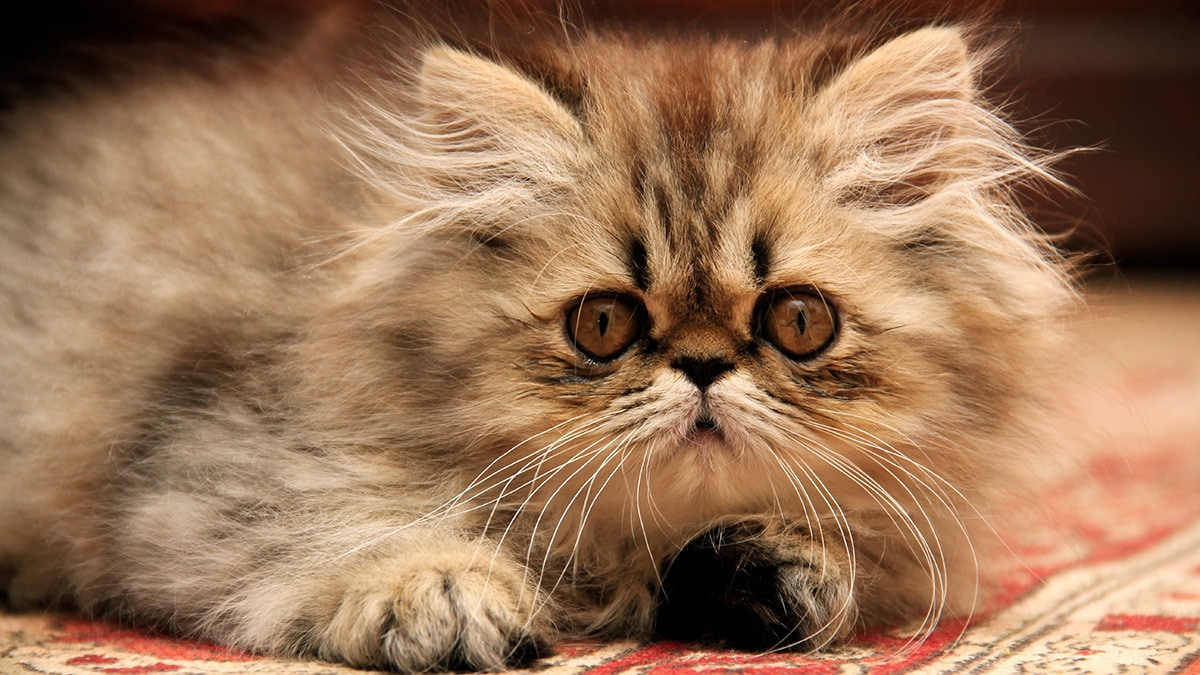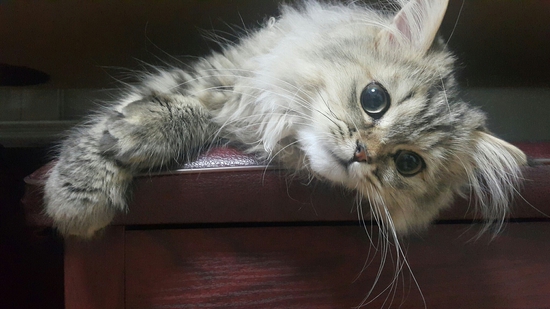
Persian Cat
Persian Cat breed
- The Persian cat is a long-haired breed of cat characterized by its round face and short muzzle.
- His beautiful, flowing coat, sweet face and calm personality have combined to make him the most popular cat breed.
- These cats have a sturdy body and thick, solid legs, which partly accounts for the fact that they are not known to be jumpers.
- The Persian purr-sonality makes her affectionate and laid back, and she is a sweet and loving family companion.
- Although she enjoys sitting in her humans’ laps and being pet, she’s just as happy to sit and observe everyone’s comings and goings from afar.
- They are mostly chosen by the cat lovers who are willing to include a silent yet an adorable member in their family.
- They’ve been around for a long time, with hieroglyphic references to the breed dating as far back as 1684 B.C.

Persian cat history
- As one of the oldest cat breeds, Persian cats can be traced all the way back to the 1600s.
- Like all modern-day domestic cats, the Persian breed is a descendent of the Felis silvestris lybica, a wildcat originally from the Middle East and North Africa.
- The Persian Empire covered a large area of the Near East including modern day Iran and Turkey.

How to care your persian cat
- Coat Maintenance: Start brushing your cat's fur at an young age. To make sure that your Persian cats have a long, silky double-coat which will matt and tangle easily if not brushed daily. This will help detangle their fur and make it easier to brush and wash.
- Ear Cleaning: Warm the olive oil or ear cleaner to body temperature by placing the container in a warm (not hot) pan of water. Use a cotton ball moistened with ear cleaner to gently wipe the cat’s ears. Gently massage the base of the ear for at least a minute, to work the liquid around.
- Eye Cleaning: Most Persian cats have “weepy” eyes and, if left untouched, can stain and build up around the cat’s eyes; sometimes leading to infection. This process turns the tears into a brown sticky substance. All you need is some warm water and cotton pads.
- Hairballs: Your Persian cat will inevitably develop hairballs, but brushing on a regular basis will greatly help prevent them from occurring. Most cats will get hairballs, not just Persians. Of course, a cat with fur as long as a Persian cat is more likely to endure them. Nothing can be done to totally prevent hairballs in cats, but there are things you can do to reduce the likelihood your cat will have hairballs or reduce their frequency.
- Nail trimming: They need to be brushed and combed daily, bathed once or twice a month, and have their nails clipped every ten days to two weeks. Be patient with the cat and if it becomes restless, stop clipping the claws and try again the next day. Front claws should be cut every couple weeks, but back claws grow slower and can be done less often.
- Bathing: A large plastic bowl with a little bit of warm water will be the ideal container to start wetting and gently soaking your cat until they don't try to run away and feel calm and confident. . A Persian cat will begin to look greasy as it becomes dirtier and mats will increase quickly if the cat is not bathed.
- Dental care: Do not try to brush the entire mouth at first. Brushing your Persian’s teeth, as with any cat, will help reduce tartar buildup and prevent dental disease. If all that your pet lets you brush is the outside of the upper teeth, you are still addressing the most important area of periodontal disease – prevention.

Variants
1. Himalayan cat
Eye color: Blue, Copper, Green
color: Tortoiseshell, Frost, Silver, Golden, Brown, Chocolate, Seal, Lilac, Blue, Black, Flame, Red, Cream, Fawn, Cinnamon
Life spam: 9-15 years
- In 1950, the Siamese was crossed with the Persian to create a breed with the body type of the Persian but colorpoint pattern of the Siamese.
- The body is short but thick with thick legs and a short, thick neck.
- Many Himalayans have been seen being pushed around in baby strollers while wearing cute clothes.
- It has been suggested that the Persian long-haired cats are descended from Pallas's cat, Felis manul, a wild cat that inhabits central Asia and which is unmarked with spots or stripes and has very long soft fur.

2. Exotic Shorthair
Eye color: Their eyes can be blue, blue-green, or copper, depending on the animal's coat color.
color: chocolate, brown, sable ci,amon lavender, silver fawn blue, gray black, ebony cream, beige, tan lilac white red, orange
Life spam: 8–15 years
- Developed through crosses between Persians and American Shorthairs, plus Burmese and Russian Blues, he has the look of the Persian but with a short, plush, easy-care coat. Here’s what you need to know if you’re considering acquiring an Exotic Shorthair.
- The Exotic is similar to the Persian in many ways, including temperament and conformation, a flat nose and face with the exceptions of the short dense coat.
- These cats are a low-maintenance breed that doesn't require a lot of space and will be as happy in an apartment as a sprawling home.

Persian cat color
There are 61 types of colors of the Persian cat.
Silver and Gold Division
- Shaded Golden
- Chinchilla Silver
- Chinchilla Golden
- Shaded Silver

Particolor Division
- Blue-Cream
- Tortoiseshell
- Lilac-Cream
- Chocolate Tortoiseshell

Himalayan Division
- Chocolate-Tortie Lynx
- Lilac-Cream Lynx
- Blue-Cream Lynx
- Lilac Lynx
- Red Lynx
- Cream Lynx
- Tortie Lynx
- Blue Lynx
- Seal Lynx
- Tortie Point
- Seal Point
- Lilac-Cream Point
- Lilac Point
- Flame Point (Red)
- Cream Point
- Chocolate-Tortie Point
- Chocolate Point
- Blue-Cream Point
- Blue Point
/GettyImages-855587394-902433e789c9423cb683be8e9c1291ce.jpg)
Bicolor Division
- Black and White
- Blue and White
- Chocolate and White
- Cream and White
- Red and White
- Calico
- Lilac and White
- Dilute Calico
- Lilac Calico
- Chocolate Calico

Tabby Division
- Blue
- Blue-Silver
- Brown
- Cameo
- Cameo-Cream
- Cream
- Silver

Solid Division
- Red
- Lilac
- Cream
- White
- Black
- Chocolate

Smoke and Shaded Division
- Shell Cameo
- Cream Smoke
- Shaded Cameo
- Cream Shaded Cameo
- Cream Shell Cameo
- Cameo Smoke (Red)
- Blue-Cream Smoke
- Blue Smoke

Blog Upload on - Jan. 20, 2022
Views - 6924
0
0 Comments

Blog Topics
Bakra Mandi List ,
इंडिया की सभी बकरा मंडी लिस्ट ,
बीटल बकरी ,
Beetal Goat ,
सिरोही बकरी ,
Sirohi Goat ,
तोतापुरी बकरी ,
Totapuri Breed ,
बरबरी बकरी ,
Barbari Breed ,
कोटा बकरी ,
Kota Breed ,
बोर नस्ल ,
Boer Breed ,
जमुनापारी बकरी ,
Jamnapari Breed ,
सोजत बकरी ,
Sojat Breed ,
सिंधी घोड़ा ,
Sindhi Horse ,
Registered Goats Breed Of India ,
Registered cattle breeds in India ,
Registered buffalo breeds in India ,
Fastest Bird in the World ,
Dangerous Dogs ,
Cute Animals ,
Pet Animals ,
Fish for aquarium ,
Fastest animals in the world ,
Name of birds ,
Insect name ,
Types of frog ,
Cute dog breeds ,
Poisonous snakes of the world ,
Top zoo in India ,
Which animals live in water ,
Animals eat both plants and animals ,
Cat breeds in india ,
Teddy bear breeds of dogs ,
Long ear dog ,
Type of pigeons ,
pabda fish ,
Goat Farming ,
Types of parrot ,
Dairy farming ,
सिंधी घोड़ा नस्ल ,
बोअर नस्ल ,
Persian Cat ,
catfish ,
बकरी पालन ,
poultry farming ,
डेयरी फार्मिंग ,
मुर्गी पालन ,
Animals ,
पब्दा मछली ,
Buffalo ,
All animals A-Z ,
दुनिया के सबसे तेज उड़ने वाले पक्षी ,
पर्सियन बिल्ली ,
What is Gulabi Goat ,
What is Cow ? ,
भैंस क्या होती है? ,
गुलाबी बकरी ,
गाय क्या होती है? ,
बकरियों का टीकाकरण ,
बीमार मुर्गियों का इलाज और टीकाकरण। ,
Animals Helpline In Uttar Pradesh ,
Animals Helpline In Maharashtra ,
Animals helpline In Punjab ,
Animals Helpline In Madhya Pradesh ,
Animals Helpline In Andhra Pradesh ,
Animals Helpline In Karnataka ,
Animals Helpline In Haryana ,
डॉग्स मैं होने वाली बीमारियां ,
उत्तर प्रदेश पशु हेल्पलाइन ,
दुनिया के दस सबसे सर्वश्रेष्ठ पालतू जानवर ,
Dog Diseases ,
Top Ten Best Pets in The World ,
महाराष्ट्र पशु हेल्पलाइन ,
बकरीद 2022 ,
मध्य प्रदेश पशु हेल्पलाइन ,
बलि प्रथा क्या है ,
Bakrid 2022 ,
What are Sacrificial Rituals ,
गाय मैं होने वाले रोग ,
Cow Desiases ,
भेड़ पालन ,
Sheep Farming ,
कबूतर पालन ,
रैबिट फार्मिंग ,
Gaushala In Uttar Pradesh ,
GAUSHALA IN HARYANA ,
DELHI BIRD & ANIMAL HELPLINE ,
Maharashtra Bird Helpline ,
गौ पालन पंजीकरण ,
बकरी पालन व्यवसाय ,
लम्पी स्किन डिजीज ,
भेड़ पालन व्यापार ,
Lumpy Skin Disease ,
Goat Farming Business ,
भारत में टॉप डॉग्स की नस्लें ,
मछली पालन व्यापार ,
डॉग को कैसे प्रशिक्षित या ट्रेन करें ,
टॉप नैचुरल फूड फॉर डॉग्स ,
Top Natural Foods for Dogs ,
How To Train A Dog ,
Fish Farming Business ,
बकरी के दूध का उपयोग ,
Use Of Goat Milk ,
Sheep Farming Business ,
बकरियों के लिए टॉप 5 सप्लीमेंट ,
Vaccination Of Goat And Sheep ,
Top 5 Supplements for Goats ,
डॉग्स के प्रकार और डॉग्स की सभी नस्लों के नाम की लिस्ट ,
Types Of All Dog Breed Names A to Z ,
Types Of Fish Breed Names A to Z ,
दुनिया के 10 सबसे बड़े जानवर ,
Types of All Goats Breed Name A to Z ,
Top 10 Longest And Heaviest Crocodiles ,
Top 10 Highest Flying Birds ,
Top 10 Largest Snake In The World ,
Top Goats Breeds For Milk ,
Major Diseases In Goats ,
Manx Cat - Cat Without A Tail ,
Top 10 Largest & Heaviest Turtles ,
Top 10 Smartest Dog Breeds ,
Name of 5 Dog that went to Space ,
The role of animals in human culture and religions ,
The role of goats in sustainable agriculture and land management ,
8 Things You Should Never Do To Your Dog ,
Green Anaconda ,
25 Amazing Types Of Snakes ( More Details ) ,
Reticulated Python ,
Black Mamba ,
King Cobra ,
Garter Snake ,
Golden Flying Snake ,
Eastern Tiger Snake ,
Benifits Of Pet Adoption ,
Top 10 Dog Safety Tips ,
Animal Behavior, Thoughts On Choosing A Breed To Raise ,
How To Get Your Dog To Listen To You ,
A to Z List of Bird Names With Picture ,
The 10 Best Dog-Friendly Places To Go In Your India ,
Healthy Habits For Animals ,
डॉग्स में होने वाले रोग ,
गाय में होने वाले रोग ,
मानव संस्कृति और धर्मों में जानवरों की भूमिका ,
बकरियों में होने वाले प्रमुख रोग ,
टिकाऊ कृषि और भूमि प्रबंधन में बकरियों की भूमिका ,



